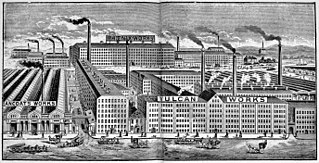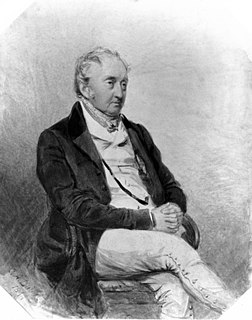B. Hick and Sons, subsequently Hick, Hargreaves & Co, was a British engineering company based at the Soho Ironworks in Bolton, England. Benjamin Hick, a partner in Rothwell, Hick and Rothwell, later Rothwell, Hick & Co., set up the company in partnership with two of his sons, John (1815–1894) and Benjamin (1818–1845) in 1833.
Platt Brothers, also known as Platt Bros & Co Ltd, was a British company based at Werneth in Oldham, North West England. The company manufactured textile machinery and were iron founders and colliery proprietors. By the end of the 19th century, the company had become the largest textile machinery manufacturer in the world, employing more than 12,000 workers.

The history of Oldham is one of dramatic change, from obscure Pennine hamlet to preeminent mill town and textile processing capital of the world. Oldham's industrial history includes hatting, coal mining, structural engineering, mechanical engineering, textile machinery manufacture and cotton spinning - for which the town is most noted.

Howard & Bullough was a firm of textile machine manufacturers in Accrington, Lancashire. The company was the world's major manufacturer of power looms in the 1860s.
Mather & Platt is the name of several large engineering firms in Europe, South Africa and Asia that are subsidiaries of Wilo SE, Germany or were founded by former employees. The original company was founded in the Newton Heath area of Manchester, England, where it was a major employer. That firm continues as a food processing and packaging business, trading as M & P Engineering in Trafford Park, Manchester.

The Lancashire Loom was a semi-automatic power loom invented by James Bullough and William Kenworthy in 1842. Although it is self-acting, it has to be stopped to recharge empty shuttles. It was the mainstay of the Lancashire cotton industry for a century.
Tweedales and Smalley was a manufacturer of textile machinery in Castleton, Rochdale, Greater Manchester, in England. It specialised in ring spinning frames mainly for export.

John Hetherington & Sons was a textile machinery manufacturer from Ancoats, Manchester in England, founded in 1830
In the recession of the 1930s, Platt Brothers, Howard and Bullough, Brooks and Doxey, Asa Lees, Dobson and Barlow, Joseph Hibbert, John Hetherington and Tweedales and Smalley merged to become Textile Machinery Makers Ltd., but the individual units continued to trade under their own names until 1970, when they were rationalised into one company called Platt UK Ltd. In 1991 the company name changed to Platt Saco Lowell. The Globe works closed in 1993.
Asa Lees was a firm of textile machine manufacturers in Oldham, Lancashire. Their headquarters was the Soho Iron Works, Greenacres. It was second only in size to Platt Brothers.
Butterworth and Dickinson were textile machinery manufacturers in Burnley, Lancashire, England. Known as "Butts and Dicks", the company made looms that were exported around the world.
Brooks & Doxey was a textile machinery manufacturer from West Gorton, Manchester in England. It was founded in 1859. It was incorporated in 1920. The company used the Union Iron Works, West Gorton. The company also had a factory in Stockport. Ferranti bought the old Union Iron Works to make mainframe computers in 1956. It later became ICT, then ICL. ICT grafted a ‘modern’ entrance on but kept the works.
Joseph Hibbert was a textile machinery manufacturer from Darwen, Lancashire in UK. The Iron, Brass and Copper Works was in Bridge Street.

Taylor, Lang & Co. was a textile machinery manufacturer based in Stalybridge, Greater Manchester, England.

Cavendish Mill is a Grade II* listed former cotton spinning mill in Ashton-under-Lyne, Greater Manchester, in the United Kingdom. It was built between 1884 and 1885 for the Cavendish Spinning Company by Potts, Pickup & Dixon of Oldham. Cavendish Mill was next to the Ashton Canal Warehouse at Portland Basin. It ceased spinning cotton in 1934 and was then used for a variety of purposes before it was converted into housing in 1994.

John Kennedy was a Scottish textile industrialist in Manchester.

The technique of sizing a warp was mechanised during the nineteenth century when William Radcliffe and his assistant Thomas Johnson invented the sizing machine. The purpose of introducing size, which is either a starchy substance for cotton or gelatinous mixture for woollen fibre, is to reduce the chances of threads fraying and breaking due to the friction of the weaving process. The size stiffens the thread and helps the fibres lie closely together. Many recipes for size can be found in textile manufacturing books. The recipes include flour, sago, china clay, types of soap, fats and some chemicals.
Ormrod and Hardcastle spinning and manufacturing firm began in 1788, with the partnership of James Ormrod and Thomas Hardcastle, and the purchase of the Flash Street mills in Bolton, Greater Manchester. These two men have been identified amongst the fathers of the early cotton trade in North West England. Others named are Carlisles, Gray, Knowles, Bulling, Crook and Culling. These names often figured prominently in the political, judicial and economic life of Bolton during its great period of growth, but sadly these names have been largely forgotten in the history of the cotton trade. By the time of their closure, in 1960, Ormrod and Hardcastle owned six large successful cotton mills in Bolton.
Richard Haworth and Co. was established by Richard Haworth in 1854 as a cotton spinning and manufacturing firm in Cannon Street, Manchester, and Tatton Mill in Salford. Today the company is part of the Ruia Group which comprises a number of companies that import, supply and distribute textiles and hosiery to retailers and hospitality organisations. Richard Haworth Ltd. supplies a range of linens to the hospitality sector.

Colonel Sir Benjamin Alfred Dobson (1847–1898) was an English textile machinery manufacturer and mayor of Bolton. He was chairman of Dobson & Barlow, the company co-founded in 1790 by his great-great-uncle Isaac Dobson.











